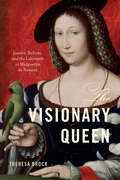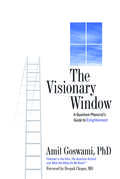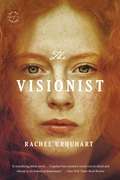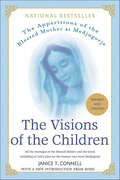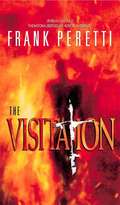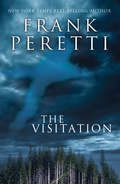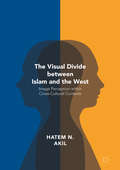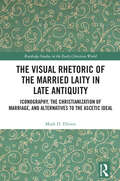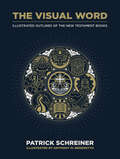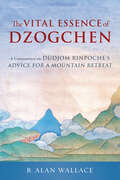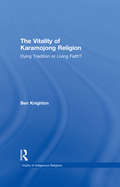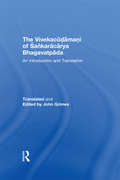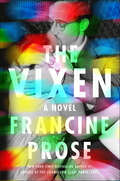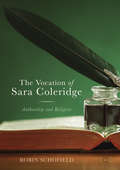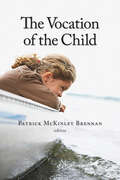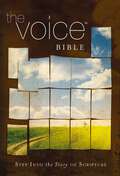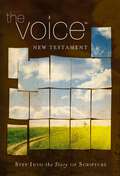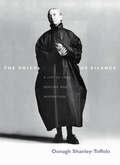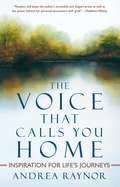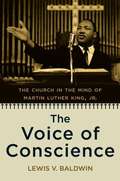- Table View
- List View
The Visionary Queen: Justice, Reform, and the Labyrinth in Marguerite de Navarre (EARLY MODERN FEMINISMS)
by Theresa BrockThe Visionary Queen affirms Marguerite de Navarre’s status not only as a political figure, author, or proponent of nonschismatic reform but also as a visionary. In her life and writings, the queen of Navarre dissected the injustices that her society and its institutions perpetuated against women. We also see evidence that she used her literary texts, especially the Heptaméron, as an exploratory space in which to generate a creative vision for institutional reform. The Heptaméron’s approach to reform emerges from statistical analysis of the text’s seventy-two tales, which reveals new insights into trends within the work, including the different categories of wrongdoing by male, institutional representatives from the Church and aristocracy, as well as the varying responses to injustice that characters in the tales employ as they pursue reform. Throughout its chapters, The Visionary Queen foregrounds the trope of the labyrinth, a potent symbol in early modern Europe that encapsulated both the fallen world and redemption, two themes that underlie Marguerite's project of reform.
The Visionary Window
by Amit Goswami M.D. Deepak ChopraAfter almost a century of using quantum physics to delve into mystery of matter, it is clear that by itself it is not complete; the conscious observer is necessary to complete it. Thus opens the visionary window, introducing into science the idea of consciousness as the ground of all being and the metaphysical basis for a new paradigm...-Adapted from the PrefaceDoes God exist? Can spirituality be integrated with science? Is happiness possible? Do miracles really happen? Not only does The Visionary Window answer " yes" to all of these questions, but it skillfully combines the fields of philosophy, cosmology, religion, and psychology to form a new way of thinking about science and spirituality.Stepping beyond the classic work of prominent seventies physicist Fritjof Capra, Goswami details his own pioneering exploration of science and spirit, revealing the complete integration between modern science and spiritual traditions. Using stories and colorful examples from pop culture, Goswami addresses complex issues in language and terminology easily accessible to the lay reader. He provides quantum physics-based theory and new experimental data verifying the metaphysical truth that exists when employed in the context of a new science, science within the primacy of consciousness.With a new holistic worldview, Goswami also discusses the creativity of the body to self heal; the power of spiritual practice and how to choose a meditative path; and the five stages of spiritual growth, culminating in the ability to transcend the physical laws of nature. Readers, scientists and spiritual leaders alike will find answers to many of life's deepest mysteries.
The Visionary Window
by Deepak Chopra Amit GoswamiDoes God exist? Can spirituality be integrated with science? Is happiness possible? Do miracles really happen? Not only does The Visionary Window answer " yes" to all of these questions, but it skillfully combines the fields of philosophy, cosmology, religion, and psychology to form a new way of thinking about science and spirituality. Stepping beyond the classic work of prominent seventies physicist Fritjof Capra, Goswami details his own pioneering exploration of science and spirit, revealing the complete integration between modern science and spiritual traditions. Using stories and colorful examples from pop culture, Goswami addresses complex issues in language and terminology easily accessible to the lay reader. He provides quantum physics-based theory and new experimental data verifying the metaphysical truth that exists when employed in the context of a new science, science within the primacy of consciousness. With a new holistic worldview, Goswami also discusses the creativity of the body to self heal; the power of spiritual practice and how to choose a meditative path; and the five stages of spiritual growth, culminating in the ability to transcend the physical laws of nature. Readers, scientists and spiritual leaders alike will find answers to many of life's deepest mysteries.
The Visionist: A Novel
by Rachel UrquhartAn enthralling first novel about a teenage girl who finds refuge--but perhaps not--in an 1840s Shaker community.After 15-year-old Polly Kimball sets fire to the family farm, killing her abusive father, she and her young brother find shelter in a Massachusetts Shaker community called the City of Hope. It is the Era of Manifestations, when young girls in Shaker enclaves all across the Northeast are experiencing extraordinary mystical visions, earning them the honorific of "Visionist" and bringing renown to their settlements.The City of Hope has not yet been blessed with a Visionist, but that changes when Polly arrives and is unexpectedly exalted. As she struggles to keep her dark secrets concealed in the face of increasing scrutiny, Polly finds herself in a life-changing friendship with a young Shaker sister named Charity, a girl who will stake everything--even her faith--on Polly's honesty and purity.
The Visions of the Children: The Apparitions of the Blessed Mother at Medjugorje
by Janice T. ConnellIn Medjugorje in Bosnia and Herzegovina, on June 25, 1981, five teenagers and a nine-year-old began telling others that they were seeing the Blessed Virgin Mary on a local mountain with the Infant Christ in her arms. The religious visions of the children continued daily. The Blessed Virgin Mary, who identified herself as the "Queen of Peace" on that day continues to bring messages for the entire world.Like Lourdes and Fatima before it, Medjugorje has become a holy pilgrimage site for Christian worshippers around the world. The Visions of the Children, Revised and Updated Edition features exclusive conversations with the six apparitioners who have been receiving, since June 1981, visions and messages of the Virgin Mary. After 25 years, three of the original visionaries continue to see the Blessed Mother daily. This revised and updated edition includes:-new information on the six visionaries who first saw Mary at Medjugorje-Messages from the Virgin Mary through June 2006-extraordinary secrets about the final chapter in the history of the world-A new, updated list of Marian Centers worldwide.This is a must have volume for anyone interested in the Blessed Virgin Mary, Marian apparitions, or Mejugorgje.
The Visitation
by Frank E. PerettiThe sleepy little town of Antioch has suddenly become a gateway for the supernatural-from sightings of angels and messianic images to a weeping crucifix. Then a self-proclaimed prophet mysteriously appears with an astounding message. The national media and the curious flock to the little town-a great boon for local business but not for Travis Jordan. The burned-out former pastor has been trying to hide his past in Antioch. Now the whole world is headed to his backyard to find the Messiah, and in the process, every spiritual assumption he has ever held will be challenged. The startling secret behind this visitation ultimately pushes one man into a supernatural confrontation that will forever alter his beliefs.
The Visitation
by Frank PerettiThe sleepy, eastern Washington wheat town of Antioch has become a gateway for the supernatural--from sightings of angels and a weeping crucifix to a self-proclaimed prophet with an astounding message.The national media and the curious all flock to the little town--a great boon for local business but not for Travis Jordan. The burned-out former pastor has been trying to hide his past in Antioch. Now the whole world is headed to his backyard to find the Messiah, and in the process, every spiritual assumption he has ever held will be challenged. The startling secret behind this visitation ultimately pushes one man into a supernatural confrontation that has eternal consequences.
The Visitor
by Liam Matthew BrockeyIn an age when few people ventured beyond their place of birth, André Palmeiro left Portugal on a journey to the far side of the world. Bearing the title âeoeFather Visitor,âe#157; he was entrusted with the daunting task of inspecting Jesuit missions spanning from Mozambique to Japan. A global history in the guise of a biography, The Visitor tells the story of a theologian whose extraordinary travels bore witness to the fruitful contactâe"and violent collisionâe"of East and West in the early modern era. In India, Palmeiro was thrust into a controversy over the missionary tactics of Roberto Nobili, who insisted on dressing the part of an indigenous ascetic. Palmeiro walked across Southern India to inspect Nobiliâe(tm)s mission, recording fascinating observations along the way. As the highest-ranking Jesuit in India, he also coordinated missions to the Mughal Emperors and the Ethiopian Christians, as well as the first European explorations of the East African interior and the highlands of Tibet. Orders from Rome sent Palmeiro farther afield in 1626, to Macau, where he oversaw Jesuit affairs in East Asia. He played a crucial role in creating missions in Vietnam and seized the opportunity to visit the Chinese mission, trekking thousands of miles to Beijing as one of Chinaâe(tm)s first Western tourists. When the Tokugawa Shogunate brutally cracked down on Christians in Japanâe"where neither he nor any Westerner had power to interveneâe"Palmeiro died from anxiety over the possibility that the last Jesuits still alive would apostatize under torture.
The Visual Divide between Islam and the West
by Hatem N. AkilThis book considers the ways in which Muslims view the way they are being viewed, not viewed, or incorrectly viewed, by the West. The book underscores a certain "will-to-visibility" whereby Muslims/ Arabs wish just to be "seen" and to be marked as fellow human beings. The author relates the failure to achieve this visibility to a state of desperation that inextricably and symmetrically ties visibility to violence. When Syrian and Palestinian refugees recently started refusing to be photographed, they clearly ushered the eventual but inevitable collapse of the image and its final futility. The photograph has been completely emptied of its last remaining possibility of signification. The book attempts to engage with questions about the ways in which images are perceived within cross cultural contexts. Why and how do people from different cultural backgrounds view the same image in opposing ways; why do cartoon, photographs, and videos become both the cause and target of bloody political violence - as witnessed recently by the deadly attacks against Charlie Hebdo in France and in the swift military response by the US, Jordan, France, and others to videotaped violence by ISIS.
The Visual Rhetoric of the Married Laity in Late Antiquity: Iconography, the Christianization of Marriage, and Alternatives to the Ascetic Ideal (Routledge Studies in the Early Christian World)
by Mark D. EllisonThis study examines third- and fourth-century portraits of married Christians and associated images, reading them as visual rhetoric in early Christian conversations about marriage and celibacy, and recovering lay perspectives underrepresented or missing in literary sources. Historians of early Christianity have grown increasingly aware that written sources display an enthusiasm for asceticism and sexual renunciation that was far from representative of the lives of most early Christians. Often called a “silent majority,” the married laity in fact left behind a significant body of work in the material record. Particularly in and around Rome, they commissioned and used such objects as sarcophagi, paintings, glass vessels, finger rings, luxury silver, other jewellery items, gems, and seals that bore their portraits and other iconographic forms of self-representation. This study is the first to undertake a sustained exploration of these material sources in the context of early Christian discourses and practices related to marriage, sexuality, and celibacy. Reading this visual evidence increases understanding of the population who created it, the religious commitments they asserted, and the comparatively moderate forms of piety they set forth as meritorious alternatives to the ascetic ideal. In their visual rhetoric, these artifacts and images comprise additional voices in Late Antique conversations about idealized ways of Christian life, and ultimately provide a fuller picture of the early Christian world. Plentifully illustrated with photographs and drawings, this volume provides readers access to primary material evidence. Such evidence, like textual sources, require critical interpretation; this study sets forth a careful methodology for iconographic analysis and applies it to identify the potential intentions of patrons and artists and the perceptions of viewers. It compares iconography to literary sources and ritual practices as part of the interpretive process, clarifying the ways images had a rhetorical edge and contributed to larger conversations. Accessibly written, The Visual Rhetoric of the Married Laity in Late Antiquity is of interest to students and scholars working on Late Antiquity, early Christian and late Roman social history, marriage and celibacy in early Christianity, and early Christian, Roman, and Byzantine art.
The Visual Word: Illustrated Outlines of The New Testament Books
by Patrick SchreinerThe New Testament shouldn&’t be complicated. So why are we often confused?Every Christian wants to love the Bible. But let&’s face it: we sometimes get lost in all the names, places, and doctrines that we find in its pages. Who wrote this epistle? Which book is about justification? Joy? Jesus? Aren&’t they all about him? The New Testament contains complex ideas and multiple genres. Keeping it straight can be hard to do. Wouldn&’t it be nice if somebody who understands the big picture would put it together for us in one place?Biblical scholar and seminary professor Patrick Schreiner draws from his years of experience as a teacher to offer a simple and memorable way of understanding Scripture. And he doesn&’t do it by throwing big words at you. The contours of the New Testament and its underlying structure are depicted in visual format along with Schreiner&’s clear explanations. In The Visual Word, the Bible comes alive because you can see it pictured before your eyes. By taking a graphic approach, you&’ll notice connections you&’ve never seen before. Gain insights you&’ve missed all these years. And discover an overall pattern that makes each separate piece fall perfectly into place.Don&’t settle for mere summaries of the New Testament. Let Schreiner&’s concise words and crisp images work together to help you encounter the Living Word in a fresh way.
The Visual Word: Illustrated Outlines of The New Testament Books
by Patrick SchreinerThe New Testament shouldn&’t be complicated. So why are we often confused?Every Christian wants to love the Bible. But let&’s face it: we sometimes get lost in all the names, places, and doctrines that we find in its pages. Who wrote this epistle? Which book is about justification? Joy? Jesus? Aren&’t they all about him? The New Testament contains complex ideas and multiple genres. Keeping it straight can be hard to do. Wouldn&’t it be nice if somebody who understands the big picture would put it together for us in one place?Biblical scholar and seminary professor Patrick Schreiner draws from his years of experience as a teacher to offer a simple and memorable way of understanding Scripture. And he doesn&’t do it by throwing big words at you. The contours of the New Testament and its underlying structure are depicted in visual format along with Schreiner&’s clear explanations. In The Visual Word, the Bible comes alive because you can see it pictured before your eyes. By taking a graphic approach, you&’ll notice connections you&’ve never seen before. Gain insights you&’ve missed all these years. And discover an overall pattern that makes each separate piece fall perfectly into place.Don&’t settle for mere summaries of the New Testament. Let Schreiner&’s concise words and crisp images work together to help you encounter the Living Word in a fresh way.
The Vital Essence of Dzogchen: A Commentary on Dudjom Rinpoche's Advice for a Mountain Retreat
by B. Alan Wallace Dudjom RinpocheA modern commentary on a classic Tibetan text of instructions for practitioners of the Dzogchen tradition of Tibetan Buddhism, with practical step-by-step instructions for advanced Nyingma teachings on realizing the nature of mind.Seamlessly interweaving the language of science with the sublime teachings of Buddhism, B. Alan Wallace presents a modern commentary on a pivotal Tibetan retreat manual, Extracting the Vital Essence of Accomplishment: Concise and Clear Advice for Practice in a Mountain Retreat by twentieth-century Nyingma master, Düdjom Rinpoché. The root text offers practical step-by-step instructions for dedicated practice in meditation retreat—wherever one may be—and Wallace&’s commentary elucidates the enduring relevance of these teachings for our contemporary context.The commentary includes four concise and powerful meditation practices, guided by Wallace, to bring the teachings into one&’s immediate experience. This volume serves as a practice manual for those familiar with the teachings of Dzogchen and as a clear guide to this pinnacle of Buddhist paths for those interested in broader questions about direct and unmediated insight into the fundamental nature of awareness. &“By extracting the essence of all meditative accomplishment through the practice of Dzogchen,&” Wallace states, &“you draw forth the vital essence of consciousness itself.&”
The Vitality of Karamojong Religion: Dying Tradition or Living Faith? (Vitality of Indigenous Religions)
by Ben KnightonHow long can a traditional religion survive the impact of world religions, state hegemony, and globalization? The ’Karamoja problem’ is one that has perplexed colonial and independent governments alike. Now Karamojong notoriety for armed cattle raiding has attracted the attention of the UN and USAID since the proliferation of small arms in the pastoralist belt across Africa from Sudan to stateless Somalia is deemed a threat to world security. The consequences are ethnocidal, but what makes African peoples stand out against state and global governance? The traditional African religion of the Karamojong, despite the multiple external influences of the twentieth century and earlier, has remained at the heart of their culture as it has changed through time. Drawing on oral accounts and the language itself, as well as his extensive experience of living and working in the region, Knighton avoids Western perspectivism to highlight the successful reassertion of African beliefs and values over repeated attempts by interventionists to replace or subvert them. Knighton argues that the religious aspect of Karamojong culture, with its persistent faith dimension, is one of the key factors that have enabled them to maintain their amazing degree of religious, political, and military autonomy in the postmodern world. Using historical and anthropological approaches, the real continuities within the culture and the reasons for mysterious vitality of Karamojong religion are explored.
The Vivekacudamani of Sankaracarya Bhagavatpada: An Introduction and Translation
by John GrimesAdvaita Vedanta is one of the most important and widely studied schools of thought in Hindu religion and the Vivekacudamani is one of the most important texts in the Advaita tradition and the most popular philosophical work ascribed to the great Indian philosopher, Sankara. Sankara (c.650-700) is considered to be a giant among giants and probably the most venerated philosopher in India's long history. The Vivekacudamani is in the form of a dialogue between a preceptor (guru) and a pupil (sisya) expounding the quintessence of Advaita in which the pupil humbly approaches the preceptor and, having served the teacher selflessly, implores to be rescued from worldly existence (samsara). The guru promises to teach the way to liberation (moksa) which culminates in the ecstatic experience of one's own Self. This book presents an accessible translation of the entire text and also includes Upanisadic cross-referencing to most of its 580 verses, extensive notes, a lengthy Introduction, list of variant readings, an extensive bibliography, and an index to the verses. All those interested in Indian religion and philosophy, Hindu studies, or Sanskrit, will find this readable English translation of an Indian philosophical classic invaluable.
The Vixen: A Novel
by Francine ProseNamed one of the best books of 2021 by NPR, The Washington Post, and Financial Times“No one states problems more correctly, more astutely, more amusingly and more uncomfortably than Francine Prose . . . The gift of her work to a reader is to create for us what she creates for her protagonist: the subtle unfolding, the moment-by-moment process of discovery as we read and change, from not knowing and even not wanting to know or care, to seeing what we had not seen and finding our way to the light of the ending.”—Amy Bloom, New York Times Book Review"Depending on the light, it’s either a very funny serious story or a very serious funny story. But no matter how you turn it, The Vixen offers an illuminating reflection on the slippery nature of truth in America, then and now."—Washington PostCritically acclaimed, bestselling author Francine Prose returns with a dazzling new novel set in the glamorous world of 1950s New York publishing, the story of a young man tasked with editing a steamy bodice-ripper based on the recent trial and execution of Ethel and Julius Rosenberg—an assignment that will reveal the true cost of entering that seductive, dangerous new world. It’s 1953, and Simon Putnam, a recent Harvard graduate newly hired by a distinguished New York publishing firm, has entered a glittering world of three-martini lunches, exclusive literary parties, and old-money aristocrats in exquisitely tailored suits, a far cry from his loving, middle-class Jewish family in Coney Island.But Simon’s first assignment—editing The Vixen, the Patriot and the Fanatic, a lurid bodice-ripper improbably based on the recent trial and execution of Ethel and Julius Rosenberg, a potboiler intended to shore up the firm’s failing finances—makes him question the cost of admission. Because Simon has a secret that, at the height of the Red Scare and the McCarthy hearings, he cannot reveal: his beloved mother was a childhood friend of Ethel Rosenberg’s. His parents mourn Ethel’s death.Simon’s dilemma grows thornier when he meets The Vixen’s author, the startlingly beautiful, reckless, seductive Anya Partridge, ensconced in her opium-scented boudoir in a luxury Hudson River mental asylum. As mysteries deepen, as the confluence of sex, money, politics and power spirals out of Simon’s control, he must face what he’s lost by exchanging the loving safety of his middle-class Jewish parents’ Coney Island apartment for the witty, whiskey-soaked orbit of his charismatic boss, the legendary Warren Landry. Gradually Simon realizes that the people around him are not what they seem, that everyone is keeping secrets, that ordinary events may conceal a diabolical plot—and that these crises may steer him toward a brighter future. At once domestic and political, contemporary and historic, funny and heartbreaking, enlivened by surprising plot turns and passages from Anya’s hilariously bad novel, The Vixen illuminates a period of history with eerily striking similarities to the current moment. Meanwhile it asks timeless questions: How do we balance ambition and conscience? What do social mobility and cultural assimilation require us to sacrifice? How do we develop an authentic self, discover a vocation, and learn to live with the mysteries of love, family, art, life and loss?
The Vocation of Lady Christine
by Sister EblanaLady Christine, though not a beauty, won friends and suitors by her education and vibrant personality. At age 20 she left the pleasures of court for the cloister. This was a time when the Carmelite convents were overrun by aristocrats and luxury. But Christine lived a truly holy and mortified life in spite of this. What did she do? She prayed and was a model religious.
The Vocation of Sara Coleridge: Authorship and Religion
by Robin SchofieldThis book presents a fundamental reassessment of Sara Coleridge. It examines her achievements as an author in the public sphere, and celebrates her interventions in what was a masculine genre of religious polemics. Sara Coleridge the religious author was the peer of such major figures as John Henry Newman and F. D. Maurice, and recognized as such by contemporaries. Her strategic negotiations with conventions of gender and authorship were subtle and successful. In this rediscovery of Sara Coleridge the author revises perspectives upon her literary relationship with Samuel Taylor Coleridge. Far from sacrificing her opportunities in service of her father’s memory, her rationale is to exploit his metaphysics in original religious writings that engage with urgent controversies of her own times. Sara Coleridge critiques the Oxford theology of Newman and his colleagues for authoritarian and elitist tendencies, and for creating a negative culture in religious discourse. In response, she experiments with methodologies of collaborative, dialogic exchange, in which form as much as content will promote liberal, inclusive and productive encounters. She develops this agenda in her major religious work, the unpublished Dialogues on Regeneration (1850–51), which this book examines in its penultimate chapter.
The Vocation of the Child (Religion, Marriage, and Family (RMF))
by Patrick Mckinley BrennanRather than discussing their possible vocation, discussions of children tend to center on their rights or duties. Does God have intentions for their young lives -- before they grow up and become &“real&” people? Distinguished jurist Patrick McKinley Brennan has gathered sixteen authors to approach this idea in various ways, from historical to psychological to theological. The authors explore throughout whether it is possible for adults to either squander their children's vocations or instead to help discover and embrace them.Contributors: Marcia Bunge Patrick McKinley Brennan John E. Coons Charles Leslie Glenn Heather M. Good Vigen Guroian William Harmless Anthony J. Kelly Bonnie Miller-McLemore Charles J. Reid Jr. Philip L. Reynolds Elmer John Thiessen George Van Grieken Robert K. Vischer William J. Werpehowski John Witte Jr.
The Voice Bible: Step Into the Story of Scripture
by Thomas Nelson. Ecclesia Bible SocietyThe VoiceTM is a faithful dynamic equivalent translation that reads like a story with all the truth and wisdom of God's Word. Through compelling narratives, poetry, and teaching, The Voice invites readers to enter into the whole story of God, enabling them to hear God speaking and to experience His presence in their lives. Through a collaboration of nearly 120 biblical scholars, pastors, writers, musicians, poets, and artists, The Voice recaptures the passion, grit, humor, and beauty that is often lost in the translation process. The result is a retelling of the story of the Bible in a form as fluid as modern literary works yet painstakingly true to the original manuscripts. Features include: Two-color text Italicized information added to help contemporary readers understand what original readers would have known intuitively In-text commentary notes that include cultural, historical, theological, or devotional thoughts Screenplay format, ideal for public readings and group studies Book introductions Presentation page for personalization Reading plans for Lent, Easter, Advent, and more Topical Guide to the Notes Topical Guide to the Scripture Part of the Signature Series line of Thomas Nelson Bibles The Voice Bibles sold to date: More than 308,000 Thomas Nelson Bibles is giving back through the God's Word in Action program. Donating a portion of profits to World Vision, we are helping to eradicate poverty and preventable deaths among children. Learn more and discover what you can do at www.seegodswordinaction.com.
The Voice New Testament: Step Into the Story of Scripture
by Thomas NelsonThe VoiceTM Bible translation is a faithful dynamic translation of the Scriptures done as a collage of compelling narratives, poetry, song, truth, and wisdom. The Voice calls the reader to step into the whole story of Scripture and experience the joy and wonder of God's revelation. Created for and by a church in great transition, The Voice uniquely represents collaboration among scholars, pastors, writers, musicians, poets, and other artists, giving great attention to the beauty of the narrative. The heart of The Voice is retelling the story of the Bible in a form as fluid as modern literary works yet remaining painstakingly true to the original manuscripts. This translation promotes the public reading of longer sections of Scripture--followed by thoughtful engagement with the biblical narrative in its richness and fullness and dramatic flow. This is an updated and revised version of the New Testament edition, now at an even more affordable price.Features include:Italicized information added to help contemporary readers understand what the original readers would have known intuitivelyIn-text commentary notes include cultural, historical, theological, or devotional thoughtsScreenplay format, ideal for public readings and group studiesBook introductions
The Voice Of Silence: A Life of Love, Healing and Inspiration
by Oonagh Shanley-ToffoloThe Voice of Silence is by an Irishwoman who has had an extraordinary life. Oonagh Shanley-Toffolo was brought up in 1930s rural Ireland where her father initiated her into the healing arts. At the age of 16, she entered a convent where she trained as a nurse, and was sent to India to look after the elderly (and knew Mother Teresa). Here, she felt it was the young, rather than the old, who needed more help and so she left her order and trained in midwifery. Later, in Paris, she was asked to nurse the Duke of Windsor just before he died - and many years later was introduced to Princess Diana and became her weekly confidante. In between, were bouts of serious illness, studying acupuncture in China - and being photographed by Snowdon. The Voice of Silence is the life story of a very unusual woman who has learned far more than most from all the remarkable things that have happened to her. It is also the author's thoughts on healing, spirituality and love - and how closely the three are intertwined. Full of feeling, poetic vision and insight, this book cannot fail to touch the heart of the reader, and inspire.
The Voice That Calls You Home
by Andrea RaynorA positive, affirming collection of essays that teaches how to understand and accept life's darkest hours -- The Voice That Calls You Home will improve the way readers live each and every day. As a hospice chaplain, cancer survivor, and a chaplain at Ground Zero following September 11, Andrea Raynor has gained a keen perspective on the meaning of life and death, comfort and grief. Through her own experiences, Raynor reminds readers that even in the most dire of circumstances, we still have the opportunity to recognize beauty, to be inspired by the tenacity of the human spirit, and to feel connected to something greater. Raynor acknowledges that we may not be able to prevent the difficulties that come in life, but we can always choose the way in which we face them. She urges us not to "live with our heads down, our eyes closed, and our hands in our pockets." Instead, she prompts us to remain open to the blessings that are all around us and to face life's challenges head-on -- "to increase our courage, re-new our hope, and unite us in the knowledge that we are not alone." In the tradition of Anne Lamott and Kate Braestrup, The Voice That Calls You Home is a warm, personal, and practical guide to appreciating the wondrous world we live in, offering perspective on how we can bear the sorrows that are sure to come with a steady eye and a sense of hope, and find the connection between the spiritual and the everyday.
The Voice of Conscience: The Church in the Mind of Martin Luther King, Jr
by Lewis V. BaldwinIn this book, Lewis V. Baldwin contends that King was fundamentally a man of the church. Beginning with King's roots in Atlanta's Ebenezer Baptist Church, Baldwin traces the evolution of King's attitude toward the church through his college, seminary, graduate school, and civil rights years. The emphasis is on King's concept of the church as "the voice of conscience. " Baldwin persuasively claims that King challenged the church over the need for a higher spiritual and ethical ideal, and that King's moral leadership and eventual martyrdom did much to reestablish the credibility of the church at a time when some theologians were declaring the death of God. Baldwin critiques the contemporary church on the basis of King's prophetic model, and concludes by insisting that this model, not the entrepreneurial spirituality of the contemporary megachurches, embodies the best potential for much-needed church renewal.
